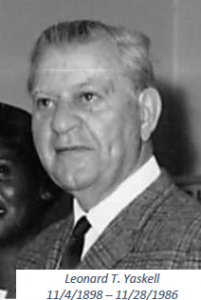
L. T. Yaskell Tells His Story

L. T. Yaskell Tells His Story
Prepared by: Bob Surridge
Hello, my name is Leonard Thadeus Yaskell…L. T. to my friends and Leonard to my wife, Louise, and, Uncle Leonard, to our lovely niece Gwendolyn. Those of you native to Southport know Louise as Louise Standland. Louise and I did not have children, but we were very involved in Gwendolyn’s life. Gwen’s mother was Louise’s older sister, Alneta. Alneta died in December 1915, when Gwendolyn was just one year old. Gwendolyn was always a joy and Louise and I were so proud when she named her daughter Alneta after her mother.
I was what people now call a “Newcomer.” I made my way to Southport shortly after World War I. I was a Marine corporal and commanded a gun crew on the cruiser USS Charleston. During my time on the Charleston, we did escort duty in the Caribbean. We also made two convoy voyages to France during hostilities and later took occupation troops to France and then brought combat veterans home.
But, I’m getting ahead of myself. I was born in 1898 in Wilkes-Barre, Pennsylvania. My father was Michael (Micha) Yatskoslavage. He came to America from Poland in 1888. My mother Mary, who was 10 years younger than my father, came in 1890. They were married in 1893. I had two older brothers Brunslaw (Bernard) and Adam, plus two younger sisters (Matilda and Stacy). My father was a coal miner. He worked in the hard coal (anthracite) mines, mines that go hundreds of feet underground. The men would say: “I no speak English, hard work…any job!”
Life was very difficult for immigrants in the coal regions and many stayed just a short time before returning to Europe. Did you know that, when my parents came here there was virtually no such thing as “illegal” immigration… anyone who was healthy and not a criminal was allowed into the country. Once here, the “hunkys” (as they called us), both men and boys…went to work in the mines 10-12 hours a day. It was a hard life, which was made more difficult because the people who came to America before us did not like us…they said we were dirty and ignorant…lower class…not worthy to be Americans…even the head of the U. S. Immigration Service said that we were not mentally and socially as good as the earlier immigrants. Many people said we were ruining American culture. In fact, in the 1921 and 1924, congress passed quota laws designed to keep Polish, Italian, Hungarian and other immigrants from central and southern Europe out of the country.
So, you’re thinking how did I get to Southport? Well, like I said, I was born in Wilkes-Barre, PA and like most sons of miners, I spent some time working in the mines. Then a friend told my father about St. Helena, North Carolina, where Mr. Hugh MacRae was selling 10 acre farms for $240…$90 down and the rest in equal payments over three years. Seeing this, my father and mother made the decision to go to St. Helena. Unfortunately, my father died (perhaps because of black lung disease) shortly after we arrived in NC, but with myself and all my brothers and sisters working with mother…we made our dairy farm work. I eventually took a job as a salesman for the Carolina Trucking and Development Company. And, it was that job that brought me to Southport in the early 1920s. Back then Southport was a dusty, windblown pogie fishing village. Sometimes the odor from the pogies would be terrible, but what Southport founder Joshua Potts called “salubrious breezes” took away the odor.
In Southport, I found some of the prettiest girls I’d ever seen. One in particular, Louise Standland caught my eye and my heart. Louise and I married in 1921 and took a house on Caswell Street. We started a grocery store and ran it together. By 1927, we were well enough off that I spent a term as the mayor of Southport. In January, 1929, Louise and I packed up our Essex sedan and made a month long trip to Wilkes-Barre, Pennsylvania to visit family and friends. Louise was shocked to learn that I had about as many relatives as there were people in Southport!
Over the years, I developed a strong interest in politics and public service. In addition to serving as the mayor of Southport, I also served as the Chairman of the Brunswick County Board of Commissioners. Then in 1935, President Franklin Delano Roosevelt appointed me to be Southport’s Postmaster. I was postmaster until 1945. However, I think my proudest time in public service came in 1939 during my tenure as chairman of the hospital’s Board of Trustees, when the Brunswick County Hospital was renamed the J. Arthur Dosher Memorial Hospital.
In the late 40s, Louise and I moved to New Jersey to help my mother and brothers run the Brick Church Restaurant in East Orange, NJ. The restaurant was near the Brick Church commuter train station that took workers to and from New York City. Location, location, location. The restaurant was very successful and we stayed in New Jersey until I retired in the early 1960s and we then returned to Southport. At that time, I was able to pick up my work with the Board of Trustees of the hospital. In 1980, I was honored to be asked to cut the ribbon at the opening of the new Southport Post Office.
As you can tell, I lived a long and I believe successful life. And, I enjoyed every minute of it. I just hope the people of Southport think I helped make Southport a better place to live.

